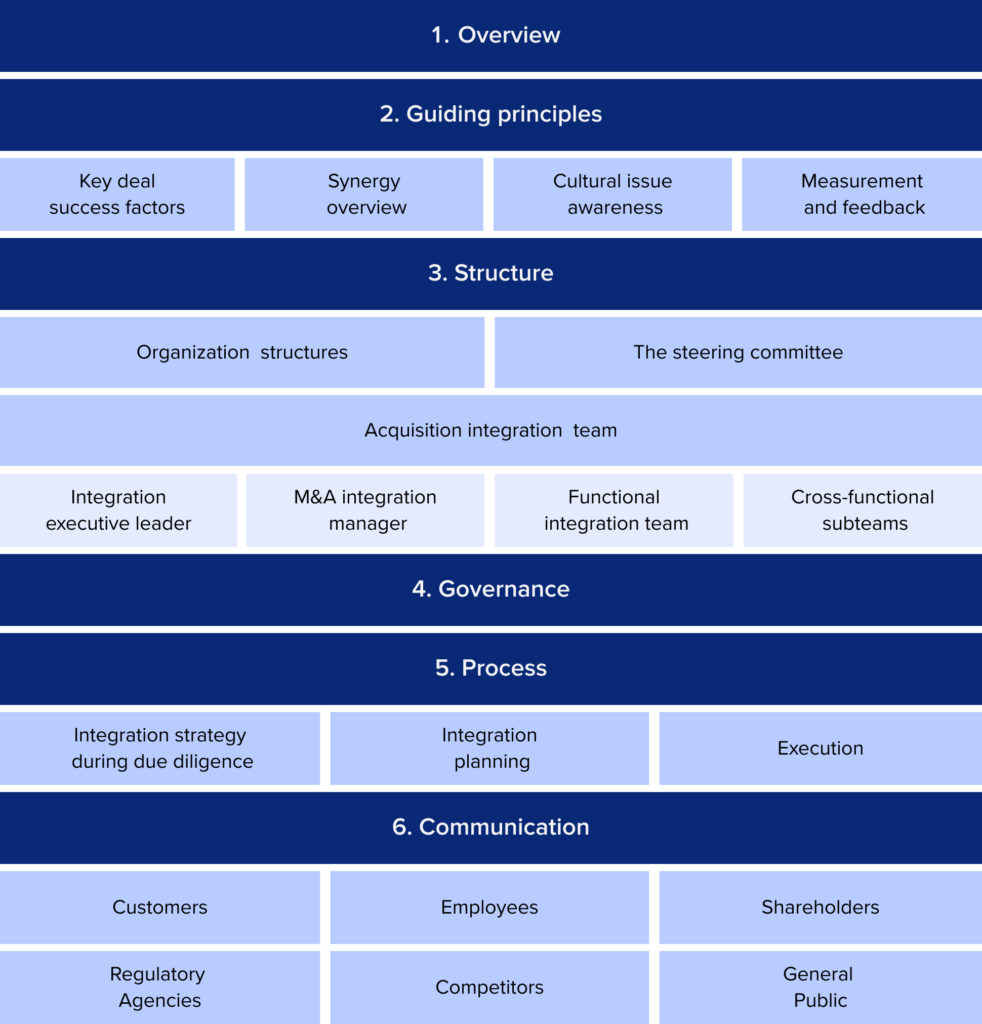Companies that integrate well, show 6-12% higher growth in comparison with companies that fail to do so.
To ensure successful M&A integration, having an M&A integration playbook is a valuable tool. This resource helps stakeholders stay aligned and provides a comprehensive view of the entire transaction lifecycle, from overarching integration plans and goals down to minor details and nuances. By utilizing the playbook, teams can better coordinate their efforts and respond more quickly to changes throughout the integration process.
What is an M&A integration playbook?
M&A integration, also known as post-merger integration or post-acquisition integration, is the process of unifying two or more companies. Its purpose is to maximize synergies and make sure the predicted value is achieved.
An M&A integration playbook is a roadmap for the M&A integration process which contains best practices, tasks, and assigned roles for team members and stakeholders. It aims to help an organization go through a complex and time-consuming integration faster and more efficiently.
A well-developed playbook functions as both a business plan and a how-to guide, that covers all the legal issues in mergers and acquisitions, keeping the integration team focused on creating the deal value while providing step-by-step guidance for tactical implementation.
Purposes of an M&A integration playbook
Businesses use M&A integration playbooks to:
- Build a framework for companies’ integration
- Enhance speed, consistency, and control throughout the entire deal
- Share files, expertise, and tools that can help during different stages of the deal lifecycle
- Prioritize initiatives and allocate resources
- Make sure each integration leader understands what they’re responsible for
- Prepare and clarify the integration activities for the involved integration teams
- Establish a team-based governance structure
Questions to ask to establish a strong playbook foundation
To make sure your integration playbook outlines your company’s particular goals, appetite for risk, operating structure, culture, and IT capabilities, consider the following questions:
Integration preparation
- What has the company learned from its previous integration activities?
- What is the company’s upcoming integration strategy?
- Who will be the key integration leaders?
Strategy development
- What are the specific integration planning steps to take during the evaluation, due diligence, closing, and post-closing phases of the deal?
- What standards and best practices need to be embraced so that data is analyzed efficiently and decisions made quickly?
- How will the organization retain the information it collects for the upcoming integration?
Distribution and communication
- How will important guiding principles be captured and shared?
- What communication tools do you have, and what should be created to support integration?
- How can the company use communication as a tool to retain critical stakeholders, such as employees and customers?
Tips on how to create a full M&A integration playbook
Keep in mind that there’s no one-size-fits-all approach to the integration playbook creation as each deal is unique and has its strategy, objectives, and resources. Still, there are some universal recommendations that many teams can focus on.
- Identify the process and tools
Discuss and define how integration teams will work and collaborate. Furthermore, specify what tools and software they will use for change management, and communication. For example, it can be a virtual data room or a project management platform.
- Specify key stakeholders
The next step is to identify the team members and stakeholders that need to be involved in the integration processes and operations, like change management experts or human resources. The list can be adjusted depending on the changing requirements and needs of the deal.
- Analyze past deals
Both an acquiring company and an acquired company should collect information and feedback from stakeholders and employees about past deals. The information should then be analyzed and applied during the creation of the current M&A integration playbook.
- Seek guidance from the experts
Find integration experts that have enough experience in the industry and have completed numerous deals successfully. They surely can share advice and tips on how to create an M&A integration playbook and sustain value creation for the long term.
- Review and update your playbook
As integration is a dynamic M&A process, the playbook should be constantly reviewed and updated. More specifically, add new operational and financial information, best practices, and tools used for bringing two companies together.
Note: Among other ways that could help during the post-merger integration process are the professional literature. Explore top mergers and acquisitions books to learn from in our dedicated articles.
M&A playbook example
Integration playbook structure and format can vary significantly depending on a specific deal. Here’s a general M&A integration playbook example that a target company can use:

Key takeaways
Here are the most critical points to remember about the M&A integration playbook creation:
- An M&A integration playbook is a roadmap for the M&A integration process which contains best practices, tasks, and assigned roles for team members and stakeholders.
- The main purposes of an M&A integration playbook are to build a framework for companies’ integration, share expertise and tools that can help during the deal, allocate resources, and make sure each integration leader understands their responsibilities.
- The steps to take during the M&A integration playbook creation are to determine the process and tools, identify stakeholders, analyze past deals, seek guidance from the experts, and update the playbook.


